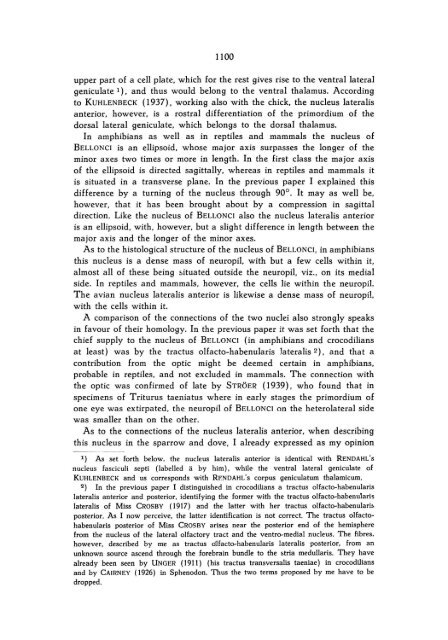The nucleus of BELLONCI in birds - DWC
The nucleus of BELLONCI in birds - DWC
The nucleus of BELLONCI in birds - DWC
You also want an ePaper? Increase the reach of your titles
YUMPU automatically turns print PDFs into web optimized ePapers that Google loves.
1100<br />
upper part <strong>of</strong> a cell plate, which for the rest gives rise to the ventral lateral<br />
geniculate 1) , and thus would belong to the ventral thalamus. Accord<strong>in</strong>g<br />
to KUHLENBECK (1937), work<strong>in</strong>g also with the chick, the <strong>nucleus</strong> lateralis<br />
anterior, however, is a rostral differentiation <strong>of</strong> the primordium <strong>of</strong> the<br />
dorsal lateral genieulate, which belongs to the dorsaI' thalamus.<br />
In amphibians as well as <strong>in</strong> reptiles and mamma Is the <strong>nucleus</strong> <strong>of</strong><br />
<strong>BELLONCI</strong> is an ellipsoid, whose major axis surpasses the langer <strong>of</strong> the<br />
m<strong>in</strong>or axes two times or more <strong>in</strong> length. In the first class the major axis<br />
<strong>of</strong> the ellipsoid is directed sagittaIly, whereas <strong>in</strong> reptiles and mammals it<br />
is situated <strong>in</strong> a transverse plane. In the previous paper I expla<strong>in</strong>ed th is<br />
difference by a turn<strong>in</strong>g <strong>of</strong> the <strong>nucleus</strong> through 90°. It may as well be,<br />
however, that it has been brought about by a compression <strong>in</strong> sagittal<br />
direction. Like the <strong>nucleus</strong> <strong>of</strong> <strong>BELLONCI</strong> also the <strong>nucleus</strong> lateralis anterior<br />
is an ellipsoid, with, however, but a slight difference <strong>in</strong> length between the<br />
major axis and the langer <strong>of</strong> the m<strong>in</strong>or axes.<br />
As to the histologieal structure <strong>of</strong> the <strong>nucleus</strong> <strong>of</strong> <strong>BELLONCI</strong>, <strong>in</strong> amphibians<br />
this <strong>nucleus</strong> is a dense ma ss <strong>of</strong> neuropil, with but a few cells with<strong>in</strong> it,<br />
almost all <strong>of</strong> these be<strong>in</strong>g ~ituated outside the neuropil, viz., on its medial<br />
side. In reptiles and mammaIs, however, the cells lie with<strong>in</strong> the neuropiI.<br />
<strong>The</strong> avian <strong>nucleus</strong> lateralis anterior is likewise a dense ma ss <strong>of</strong> neuropil.<br />
with the cells with<strong>in</strong> it.<br />
A comparison <strong>of</strong> the connections <strong>of</strong> the two nuclei also strongly speaks<br />
<strong>in</strong> favour <strong>of</strong> their homology. In the previous paper it was set forth that the<br />
chief supply to the <strong>nucleus</strong> <strong>of</strong> <strong>BELLONCI</strong> (<strong>in</strong> amphibians and crocodilians<br />
at least) was by the tractus olfacto~habenularis Jateralis 2) , and that a<br />
contribution from the optie might be deemed certa<strong>in</strong> <strong>in</strong> amphibians,<br />
prdbable <strong>in</strong> reptiles, and not excluded <strong>in</strong> mam mals. <strong>The</strong> connection with<br />
the optic was confirmed <strong>of</strong> late by STRÖER (I 939) , who found that <strong>in</strong><br />
specimens <strong>of</strong> Triturus taeniatus wh ere <strong>in</strong> early stages the primordium <strong>of</strong><br />
one eye was extirpated, the neuropil <strong>of</strong> <strong>BELLONCI</strong> on the heterolateral side<br />
was smaller than on the other.<br />
As to the connections <strong>of</strong> the <strong>nucleus</strong> lateralis anterior, when describ<strong>in</strong>g<br />
this <strong>nucleus</strong> <strong>in</strong> the sparrow and dove, lalready expressed as my op<strong>in</strong>ion<br />
1) As set forth below. the <strong>nucleus</strong> lateralis anterior is identical with RENDAHL's<br />
<strong>nucleus</strong> fasciculi septi (labelled ä by him). while- the ventral lateral geniculate <strong>of</strong><br />
KUHLENBECK and us corresponds with RFNDAHL's corpus geniculatum thalamicum.<br />
2) In the previous paper I dist<strong>in</strong>guished <strong>in</strong> crocodilians a tractus olfacto-habenularis<br />
lateralis anterior and posterior. identify<strong>in</strong>g the former with the tractus olfacto-habenularis<br />
lateralis <strong>of</strong> Miss CROSBY (1917) and the latter with her tractus olfacto-habenulari~<br />
posterior. As I now perceive. the latter identification is not correct. <strong>The</strong> tractus oHactohabenularis<br />
posterior <strong>of</strong> Miss CROSBY arises near the posterior end <strong>of</strong> the hemisphere<br />
from the <strong>nucleus</strong> <strong>of</strong> the lateral olfactory tract and the ventro-medial <strong>nucleus</strong>. <strong>The</strong> fibres.<br />
however. described by me as tractus dJfacto-habenularis lateralis posterior. from an<br />
unknown souree ascend through the forebra<strong>in</strong> bundIe to the ~tria medullaris. <strong>The</strong>y have<br />
already been seen by UNGER (1911) (his tractus transversalis taeniae) <strong>in</strong> crocodilians<br />
and by CAIRNEY (1926) <strong>in</strong> Sphenodon. Thus the two terms proposed by me have to be<br />
dropped.
















